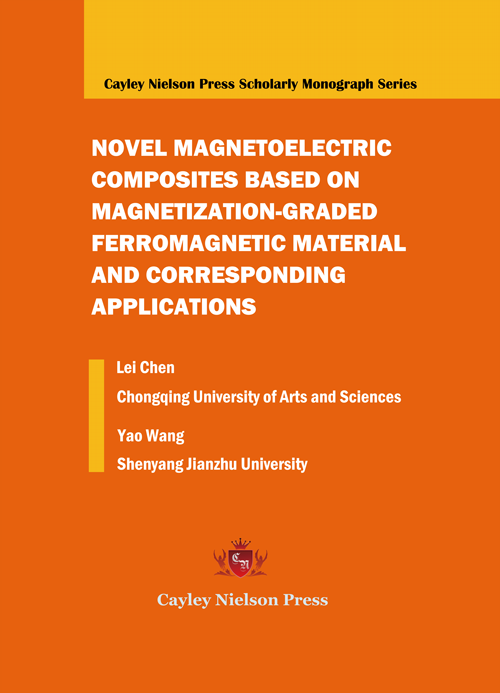
NOVEL MAGNETOELECTRIC COMPOSITES BASED ON MAGNETIZATION-GRADED FERROMAGNETIC MATERIAL AND CORRESPONDING APPLICATIONS

Lei Chen
Chongqing University of Arts and Sciences
Yao Wang
University of Minnesota - Twin Cities
Copyright © 2017 by Cayley Nielson Press, Inc.
ISBN: 978-0-9992443-7-1
Cayley Nielson Press Scholarly Monograph Series Book Code No.: 144-6-2
US$150.50
Preface
The magnetoelectric (ME) effect is the result of a “product property”, i.e., the mechanical deformation due to magnetostriction results in a dielectric polarization due to the piezoelectric effect. Such effects can realize the energy conversion between the electric field and the magnetic field. In recent decades, considerable research efforts have been put into the ME effect, first in single-phase multiferroic materials, then in piezoelectric/magnetostrictive bulk composites, and recently in piezoelectric/magnetostrictive laminated composites. It has been reported that the large ME voltage coefficient makes the ME composites suitable for applications in magnetic field sensors, transformers, actuators, and transducers.
In general, the strength of the ME effect is determined by both the piezoelectric and piezomagnetic coefficients for material. However, the values of piezomagnetic coefficients for the most magnetostrictive material are close to zero at zero-biased magnetic field, such piezoelectric/magnetostrictive laminated composites need to be provided with an external dc bias magnetic field to produce high ME response. The needs for a magnetic bias field cause some significant disadvantages for the practical application of highly precise, sensitive and miniature magnetic sensor devices, such as adding a potential noise source, reducing the spatial resolution and increasing the device volume and costs.
In fact, combining traditional magnetostrictive/piezoelectric laminated composites with magnetization-graded ferromagnetic materials can obtain highly zero-biased ME response. In this book, the authors discuss these ME composites based on magnetization- graded ferromagnetic materials from both experimental and theoretical perspectives.
This book is composed of six chapters. The structure of the book is as follows. Chapter 1 introduces the current research progress and results of ME composite from the theoretical and experimental aspects. Chapter 2 analyzes and compares the ME effects of different ME laminate composites. Specifically, effects of layer structure and ferromagnetic material on ME performance are investigated. Chapter 3 focuses on dynamic magnetostriction characteristics of novel magnetization-graded ferromagnetic materials. Chapter 4 systematically introduces and comprehensively analyzes the ME composites based on magnetization graded ferromagnetic materials with both theoretical model and experimental testing method. Chapter 5 dwells on the optimized ME composites based on magnetization- graded ferromagnetic materials by adjusting the composite configuration, selecting more suitable ferromagnetic material and improving self-biased ME effect for the optimized ME composite. Chapter 6 presents the main application of these composites.
Chen-Lei
Chongqing University of arts and sciences
Chongqing, China
April 31, 2017
Contents
1 Introduction
1.1 The Current Research Results
1.1.1 Theoretical Results
1.1.2 Materials and methods
1.2 Problems
1.3 Contents of This Monograph
2 Magnetoelectric Effects in Traditional Magnetostric- tive - Piezoelectric composites
2.1 Introduction
2.2 Bilayer magnetoelectric composites
2.3 Three-layer magnetoelectric composites
2.4 Different Layer Structures of Magnetoelectric composite
3 Dynamic Magnetostriction Characteristics of the Magnetization-graded Ferromagnetic Materials
3.1 Introduction
3.2 The magnetization-graded ferromagnetic material
3.3 Experimental Data
3.3.1 Dynamic Magnetostriction Characteristics
3.3.2 The Magnetization-graded Ferromagnetic Materials with different layers of FeCuNbSiB
4 Magnetoelectric composites based on magnetization graded ferromagnetic materials
4.1 Introduction
4.2 Theoretical analysis
4.2.1 Working Model
4.2.2 Dynamic effective piezomagnetic coefficient
4.2.3 The magnetoelectric voltage coefficients
4.3 Theoretical results and discussions
5 Self-biased Magnetoelectric effect in different magnetization-graded ME composite
5.1 Introduction
5.2 Three-phase magnetization-graded ME composite
5.3 Multilayered magnetization-graded ME composite
6 Applications
6.1 Magnetic field sensor
6.2 Magnetoelectric Transducer
References
Readership
This book should be useful for students, scientists, engineers and professionals working in the areas of optoelectronic packaging, photonic devices, semiconductor technology, materials science, polymer science, electrical and electronics engineering. This book could be used for one semester course on adhesives for photonics packaging designed for both undergraduate and graduate engineering students.
